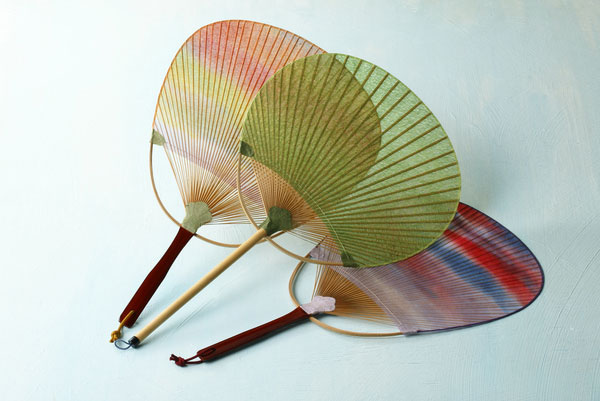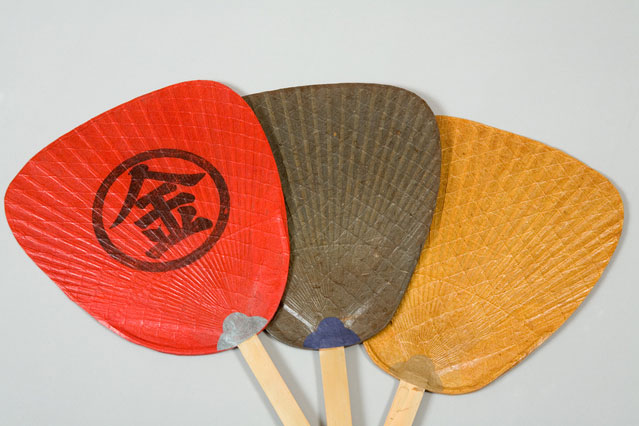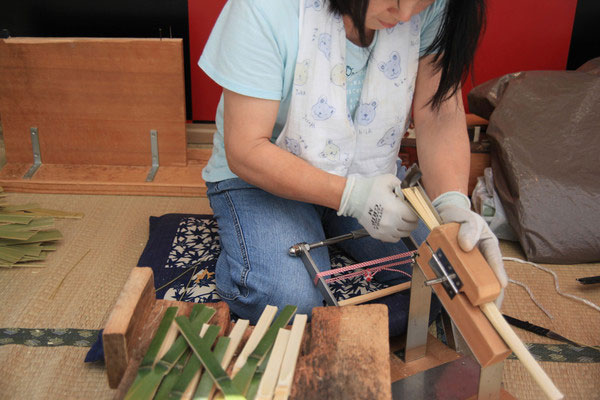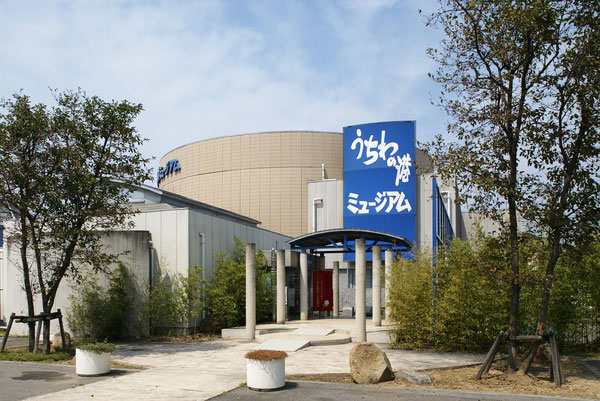
- Other crafts
- Kagawa
Marugame uchiwa fans Marugame uchiwa
Fans made from a single piece of bamboo
Still an important piece of Japanese daily life
Description
What is Marugame uchiwa fans ?
Marugame uchiwa are a type of fan made in the area around the city of Marugame, Kagawa prefecture. It is believed that, in the early Edo period (1603-1868), the first Marugame uchiwa were made as souvenirs for pilgrims to the Konpira Shrine. The original design included a vermillion ground color and an enclosed character meaning gold in the center to represent the shrine, with the whole surface coated with persimmon tannin.
During the years 1781-1789, low-ranking samurai in the Marugame domain were encouraged to make fans to supplement their income, and production grew to become a well-known local industry. The fan handle and framework are often made from a single piece of bamboo, and handle designs come in flat and round shapes. Marugame uchiwa makes up for a large part of production of domestic fans.
Although the mass production of fans made of resin account for most production, bamboo fans incorporating the traditional skills of craftsmen are considered to have more character.
Marugame uchiwa are light, fit the hand well, and are comfortable to use, with a kind of depth not shared by resin fans. Fan production peaked around 1955, followed by a fall in demand due to the increasing popularity of electric fans and air conditioners.
These fans are revered throughout Japan as a successful local industry, and artisans keep developing folk-art fans and elaborately designed interior fans.
History

Marugame uchiwa is a fusion of three traditions. The first is a persimmon tannin-covered fan made during the Edo period (1603-1868) from a thicker bamboo with a round pattern, developed in 1633 by a chief priest of the temple attached to the Konpira Shrine. The second tradition is a fan made from thinner bamboo with a round pattern, the production of which was sponsored by the Marugame domain in the 1780s. Thirdly, a flat handled shioya fan modeled after traditional fans typical of Nara, which was promoted by a wholesale store in the town of Tomiya during the Meiji period (1868-1912).
Takijirou OKUBO opened a factory in Shioya village sometime between 1892 and 1896. In 1894, the first incorporated business in the fan industry, the Marugame Fan Limited Partnership Company, was established. In 1904, the Oya Company was established to sell flat handle fans directly from factories to outlets outside the prefecture, which would lead to the development of overseas markets in India and the US. In the early Taisho era (1912-1926), Takejiro WAKI made cutting and drilling machines to simplify the process of fan making, and since local businesses were permitted to freely use these new machines, fan production greatly increased. This made Marugame the most popular fan production area in Japan.
In addition, the invention of a logo printing machine between 1933 and 1935 gave the industry a boost. Marugame fans with individual printed or company names became popular as promotional goods or commemorative items.
After 1938, and during World War II, production increased, with flat handle fans becoming a new staple product and replacing the thinner handle fans. Production of Marugame fans hit a peak between 1955 and 1964 after which Japan embraced electric fans and air conditioning leading sales to drop. Still, it is revered as one of the great crafts in Japan and loved by people who appreciate genuine pieces and enjoy a more eco-friendly lifestyle.
Production Process

- 1. Cutting bamboo
Making use of the breakable nature of bamboo wood, logs are cut into 40 to 45 cm (about 17.7 in) lengths, and then split into equal widths. These narrow strips are then shaved on the inner surface of the bamboo joint, so that they are comfortable to hold.
- 2. Splitting bamboo
A cutting machine is used to make 35 to 45 lengthwise cuts of about 10 cm (about 3.9 in) that start from the head of the bamboo.
- 3. Drilling holes
A drill is used to make a hole in the joint of the bamboo. Then another specialized craftsman sticks a sickle into the hole.
- 4. Pattern carving
A small knife is used to carve the uchiwa's pattern. The type of pattern depends on the kind of fan.
- 5. Entwining thread
After passing a bamboo bar through the hole, the ends are entwined with thread.
- 6. Binding
Since the ends will have warped in the entwining process, the angle of the bamboo bar is adjusted to make the fan symmetrical, and then bound with thread.
- 7. Pasting paper
The head of the fan is covered with glue and paper.
- 8. Cutting shapes
The edges are cut into shapes like a full moon or an egg. A sickle is placed on the fan and hit with a mallet.
- 9. Finishing touches
A long paper slip is pasted to make the edges of the fan secure. Then strips of paper are glued on both sides of the bamboo bar. Finally, the fan is pressed with a roller to finish.
Facility Information
Uchiwa No Minato Museum

-
Address
-
Tel.+81-877-24-7055
-
ClosedWednesdays (open if Wednesday is holiday and closed the next day) and December 29 to January 3
-
Business Hours9:30am to 5pm
-
Website
Other Other crafts
- Edo kiriko cut glass
- Koshu lacquered deer leather
- Kyo folding fans
- Marugame uchiwa fans
- Boshu uchiwa fans
- Gifu lanterns
- Yamaga lanterns
- Kyo uchiwa fans
- Tendo Japanese chess pieces
- Edo glass
- Edo patterned paper
- Yame lanterns
- Owari Cloisonné
- Fukuyama Koto (Japanese Harp)
- Kyo art preservation
- Banshu fly-fishing flies
- Woodblock prints
- Koshu hand-carved seals
- Edo Hyogu (Art Mountings)
- Edo tortoise shell crafts
- Etchu Fukuoka Sedge Hats
- Gifu Japanese Umbrellas
- Nagasaki tortoise shell crafts
- Nagoya Sekku Kazari
- Sanshin
- Tokyo Koto (Japanese Harp)
- Tokyo Shamisen































































































































































































































































































